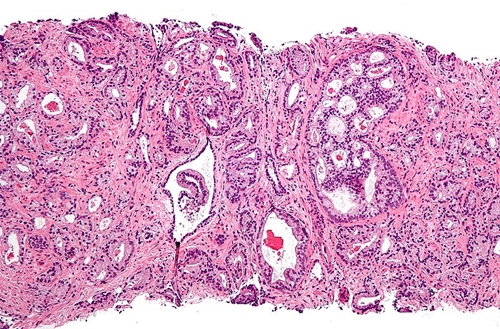
Micrograph of prostatic acinar adenocarcinoma, the most common form of prostate cancer (Nephron, Wikimedia Commons)
22 May 2015. An analysis of biopsy samples from men with prostate cancer that spread to other parts of their bodies identifies genomic anomalies found in nearly 90 percent in men with the condition, for which treatments may be available. Findings from the team at eight institutions in the U.S. and U.K. appear today in the journal Cell (paid subscription required).
The researchers led by Arul Chinnaiyan at University of Michigan in Ann Arbor and Charles Sawyers at Memorial Sloan Kettering Cancer Center in New York developed a comprehensive genetic map of metastatic castration resistant prostate cancer, an advanced form of the disease that spreads to other parts of the body. Their study collected biopsy samples from 150 men who were not responding to standard hormone-based treatments, taken from bone, soft tissue, lymph nodes, and liver — areas previously considered difficult to access for this genomic analysis.
The results found about two-thirds of the men with mutations in the androgen receptor gene that provides the code for making testosterone and other hormones related to male sexual development. This finding was expected given the lack of response by participants to standard hormone therapies, but it also provides targets for alternative hormone-based treatments.
Some 14 percent of participants were found with mutations in BRCA1 and BRCA2 genes, usually associated with breast and ovarian cancer. However, identifying these mutations could make available new drugs known as PARP inhibitors designed to treat ovarian cancer from BRCA gene mutations, for patients with prostate cancer having these mutations. Another 8 percent of the individuals were found with germline or inherited genetic alterations that made them more predisposed to the disease, which supports arguments for screening people with a family history of the disease.
As important as the findings, say the authors, is the process designed for capturing and analyzing genetic data that could be applied to diagnosing underlying causes of an individual’s prostate cancer and identifying appropriate treatments. Most previous studies focus on genomics of the primary prostate cancer, with few results that point to available therapies. In this case, however, the researchers investigated where prostate cancer spreads and found in most cases, actions of some kind could be taken.
“One of the surprising findings in this study was that approximately 90 percent of cases harbored some kind of genetic anomaly that was clinically actionable, meaning we have potential treatments to target that specific aberration,” says Chinnaiyan in a university statement. “This suggests that clinical genomic sequencing could impact treatment decisions in a significant number of patients with disease.”
Read more:
- Gene Editing Harnessed to ID Cancer Targets
- Collaboration Collecting Data to ID Precise Cancer Meds
- Inexpensive Test Bests PSA for Prostate Cancer Screening
- Cloud Pharma, Univ of Florida Partner on Cancer Drug Design
- System Personalizes Cancer Nanomedicine Treatments
* * *

 RSS - Posts
RSS - Posts
You must be logged in to post a comment.